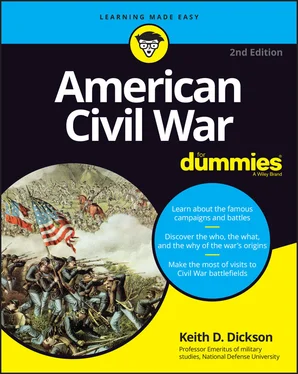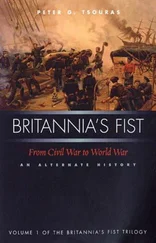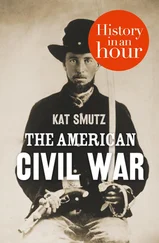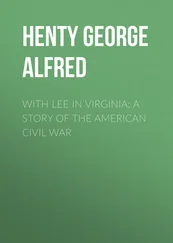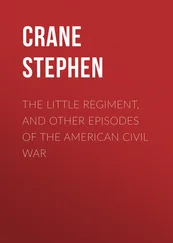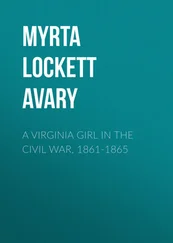Keith D. Dickson - American Civil War For Dummies
Здесь есть возможность читать онлайн «Keith D. Dickson - American Civil War For Dummies» — ознакомительный отрывок электронной книги совершенно бесплатно, а после прочтения отрывка купить полную версию. В некоторых случаях можно слушать аудио, скачать через торрент в формате fb2 и присутствует краткое содержание. Жанр: unrecognised, на английском языке. Описание произведения, (предисловие) а так же отзывы посетителей доступны на портале библиотеки ЛибКат.
- Название:American Civil War For Dummies
- Автор:
- Жанр:
- Год:неизвестен
- ISBN:нет данных
- Рейтинг книги:4 / 5. Голосов: 1
-
Избранное:Добавить в избранное
- Отзывы:
-
Ваша оценка:
- 80
- 1
- 2
- 3
- 4
- 5
American Civil War For Dummies: краткое содержание, описание и аннотация
Предлагаем к чтению аннотацию, описание, краткое содержание или предисловие (зависит от того, что написал сам автор книги «American Civil War For Dummies»). Если вы не нашли необходимую информацию о книге — напишите в комментариях, мы постараемся отыскать её.
American Civil War For Dummies,
American Civil War For Dummies
American Civil War For Dummies — читать онлайн ознакомительный отрывок
Ниже представлен текст книги, разбитый по страницам. Система сохранения места последней прочитанной страницы, позволяет с удобством читать онлайн бесплатно книгу «American Civil War For Dummies», без необходимости каждый раз заново искать на чём Вы остановились. Поставьте закладку, и сможете в любой момент перейти на страницу, на которой закончили чтение.
Интервал:
Закладка:
 Of the 1.4 million white families in the South in 1860, there were only 383,000 slaveholders. Only 46,000 planters owned 20 slaves, fewer than 3,000 owned 100 or more slaves, and only 12 Southerners owned 500 or more slaves. One individual owned 1,000 slaves. He was the richest man on the planet. Thus, only a tiny minority of people owned slaves in the South.
Of the 1.4 million white families in the South in 1860, there were only 383,000 slaveholders. Only 46,000 planters owned 20 slaves, fewer than 3,000 owned 100 or more slaves, and only 12 Southerners owned 500 or more slaves. One individual owned 1,000 slaves. He was the richest man on the planet. Thus, only a tiny minority of people owned slaves in the South.
The rarified air of highly sophisticated historical minds harbors many intricate pet theories to account for the South’s connection with slavery, but let’s keep it simple. Wealthy slave owners were men of high social status and held political power. They were the ones who ran the state legislatures and elected men of their kind to Congress. Not surprisingly, they enjoyed great influence over Southern society and their attachment to, and defense of, slavery represented a broad consensus. Although Southern society was highly stratified, there was — in the often rough and violent Southern frontier, regardless of social position or wealth — a sense of rough equality where a white man demanded equal treatment and respect from other white men. Because it was an integral part of the landscape of the South, the institution of slavery bound slaveholders and non-slaveholders together politically, culturally, and economically. When questions arose about the future direction of the country after the Mexican-American War, slaveholders and non-slaveholders, sharing the same outlook and interests, united to defend the institution to prevent any limitation.
The North, during this same time period, was setting the stage for the industrial revolution that would transform the nation in the next hundred years. Technology harnessed to both agriculture and industry, plus a huge influx of immigrants to serve as a ready labor force, created a new dynamic economy. Textile mills (run on Southern cotton), steam engines, railroads and canals, and iron and steel factories came to dominate the landscape of New England, Pennsylvania, and Ohio. In 1860, the North held about 140,000 factories, which employed nearly a million and a half workers, who produced almost $2 billion worth of goods. New cities in the northwest such as Pittsburgh, Cincinnati, Chicago, Buffalo, Cleveland, Detroit, and Milwaukee became the engines of change in the national economy. St. Louis and New Orleans became the centers of a dynamic interregional trade. Within this atmosphere of economic change and readjustment between 1850 and 1860, the North and South were becoming more disparate, confidently moving, it seemed, in two different directions.
The Opposing Sides
The North and the South agreed on one thing: that the future of America lay in the vast open territory of the West. The troubling question was which section of the country would determine the nation’s destiny? Most of this territory had been won from Mexico after the Mexican-American War in 1846, and Northerners and Southerners disagreed over the future organization of this territory into states. The road to war began with a political struggle between the North and the South over how the western territories would be organized into states and enter the Union. This political struggle had its origins in the extensive social changes influencing the North after 1830. A religious revival known as the Second Great Awakening swept from New England into the new states of the Midwest with a message of moral revival and striving for individual perfection. Adherents believed that not only should men and women seek spiritual and personal purity through hard work and personal rectitude, but the whole of society must also be purged of unwholesome elements. Two of the most prominent threats to achieving this perfection in society were the moral evils of liquor and of slavery. Prohibition movements sprang up throughout the North, as did a movement to abolish slavery. Although these movements were not entirely popular in the North, they gained wider and deeper influence in the realm of politics.
Another powerful idea that shaped attitudes of Northerners was the notion of free labor. The future of America was a land of free white men who would move west and build happy and prosperous lives from their own efforts. This powerful vision also gained influence within Northern political circles, even to the extent of creating a new sectional political party, the Free Soil Party. Increasingly, the South was perceived as being a barrier to the limitless potential that a morally perfect country of free individuals could enjoy. Many in the North perceived Southerners as morally unfit, tainted by slavery, an institution that degraded small farmer and planter alike, making them listless, dull-witted, cruel, and violent. For Southerners, the writing was on the wall. In their vision of the future of America, the prosperity of the cotton economy would naturally expand westward. Cotton depleted the soil, requiring expansion westward to put more land into production. Without this expansion, the Southern economy would be condemned to a slow death. Of course, the westward expansion of the cotton economy meant that Southerners expected to bring slaves into the new territories.
 Free labor became the catchphrase that heightened political divisions in the country. Only free (not slave) men could ensure a golden future for America. By extension, this meant that slave labor was neither legitimate nor welcome in the great West. Slavery, therefore, had to be limited and eventually destroyed if America was to fulfill its destiny. This concept had nothing to do with the status of Black men — free or otherwise — they had no place in this vision of the future. Southerners, hearing this message, and sensing that it was gaining political momentum, quickly recognized the threat to their own future in America, a place where the free labor advocates said they had no part to play.
Free labor became the catchphrase that heightened political divisions in the country. Only free (not slave) men could ensure a golden future for America. By extension, this meant that slave labor was neither legitimate nor welcome in the great West. Slavery, therefore, had to be limited and eventually destroyed if America was to fulfill its destiny. This concept had nothing to do with the status of Black men — free or otherwise — they had no place in this vision of the future. Southerners, hearing this message, and sensing that it was gaining political momentum, quickly recognized the threat to their own future in America, a place where the free labor advocates said they had no part to play.
WILMOT’S PROVISO
The Wilmot Proviso was a resolution made by an obscure Pennsylvania Congressman, David Wilmot, who, in 1846, attached the proviso (a conditional clause inserted into legislation or a contract) to an appropriations bill. Wilmot’s proviso stated that any territory acquired in the war with Mexico would not be open to slavery. The bill passed the House of Representatives, where the North had a majority, but it died in the Senate, where the South held the balance of power. The controversy over the Wilmot Proviso illustrated to both sections how important political control in Congress was to furthering their interests. The proviso became the basis of the increasingly bitter political struggle throughout the 1850s.
The political battle lines were drawn in 1846 with the Wilmot Proviso, which reflected the increasingly dominant opinions of Northerners who desired to bring about their vision of the future. It declared that any territory obtained from Mexico would be closed to slavery. The voices of an increasingly vocal and influential group of New England and Midwest abolitionists demanded a final reckoning with the South. The abolitionists felt that containing slavery only to where it currently existed (so that it would eventually die out) was a step in the right direction, but the only solution was destroying the institution altogether. As long as slavery existed, they believed, the future health of the republic was in danger. Allowing slavery to expand into the new territories would only lengthen the life of the institution, and in the end it would destroy the democratic base upon which the nation had been founded. Abolitionists and their supporters spoke darkly of the “slave power,” a tyrannical, satanic entity in the South that sought to undermine and overwhelm the North. Southerners responded by loudly defending slavery as a positive good, benefitting both masters and slaves alike.
Читать дальшеИнтервал:
Закладка:
Похожие книги на «American Civil War For Dummies»
Представляем Вашему вниманию похожие книги на «American Civil War For Dummies» списком для выбора. Мы отобрали схожую по названию и смыслу литературу в надежде предоставить читателям больше вариантов отыскать новые, интересные, ещё непрочитанные произведения.
Обсуждение, отзывы о книге «American Civil War For Dummies» и просто собственные мнения читателей. Оставьте ваши комментарии, напишите, что Вы думаете о произведении, его смысле или главных героях. Укажите что конкретно понравилось, а что нет, и почему Вы так считаете.
